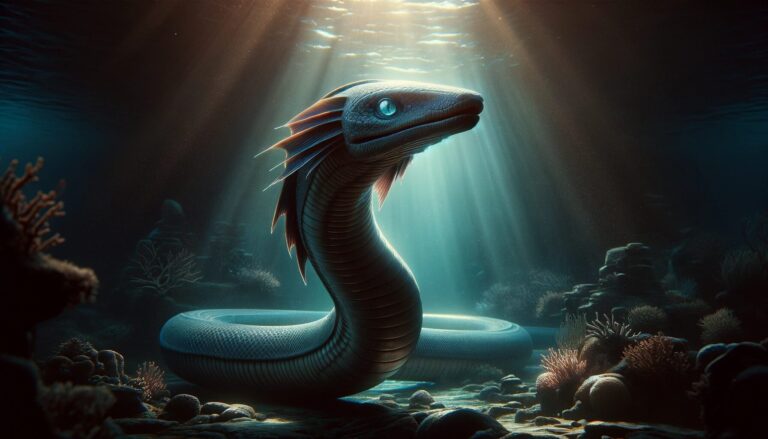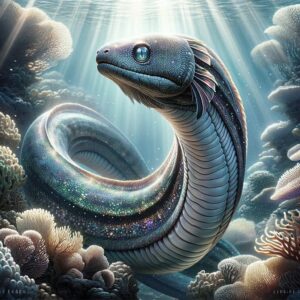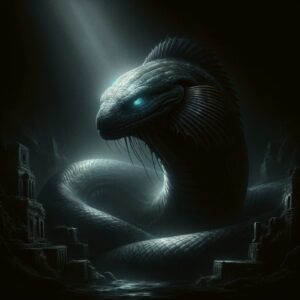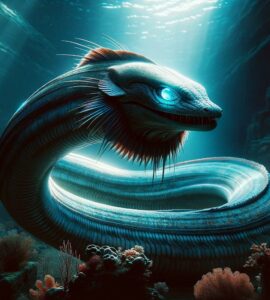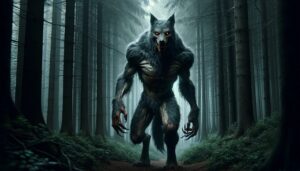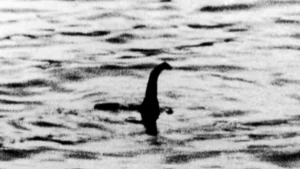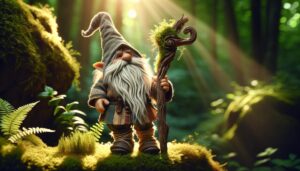Table of Contents
In Ashanti mythology, Abaia is sometimes associated with water spirits and is seen as a guardian or protector of the aquatic ecosystem. It is also considered a deity by some, and offerings and rituals are made to appease and seek favor from Abaia to ensure safe travels and a bountiful harvest from the waters.
Abaia is just one of many mythical creatures and spirits found in the rich folklore and mythology of various African cultures. These creatures often have symbolic and spiritual significance within their respective traditions.
The origin of the myth of Abaia can be traced back to the Ashanti people of Ghana, West Africa. The Ashanti are one of the Akan ethnic groups in the region, and their cultural and religious beliefs include a rich tapestry of myths, legends, and folklore. Abaia is a creature that features prominently in the oral traditions and stories of the Ashanti people.
The specific origins of Abaia within Ashanti mythology are not well-documented, as these myths have been passed down orally from generation to generation for centuries. However, it is likely that Abaia, like many other mythical creatures in African folklore, has roots in the cultural and spiritual beliefs of the Ashanti people, with influences from their environment, such as the presence of rivers, lakes, and other bodies of water that played a significant role in their daily lives.
Mythical creatures like Abaia often serve various cultural, religious, and educational purposes within indigenous societies, conveying moral lessons, explaining natural phenomena, and reinforcing social norms and values. While the specific origins of Abaia may remain shrouded in the mists of time, its significance within Ashanti culture is a testament to the enduring power of folklore and mythology in shaping the beliefs and identity of a people.
Physical Description
The physical description of Abaia can vary somewhat in different versions of Ashanti folklore and oral traditions. However, there are some common characteristics associated with this mythical creature:
Serpent-Like: Abaia is typically described as a giant, serpent-like creature. It is often depicted as a massive snake, although some versions of the myth may describe it as having multiple heads or other serpent-like features.
Enormous Size: Abaia is said to be of enormous size, with some accounts suggesting that it can be as long as a river or lake itself. Its sheer size contributes to its awe-inspiring and intimidating presence.
Shimmering Scales: In some versions of the myth, Abaia is described as having scales that glisten and shimmer, which adds to its mystical and otherworldly appearance.
Protective Eyes: Abaia is often associated with being a guardian or protector of the aquatic ecosystem. Its eyes are said to be watchful and vigilant, ensuring the well-being of the creatures that inhabit the waters it resides in.
Control Over Water: Abaia is believed to have the power to control the currents and tides of the rivers and lakes where it dwells. It can use this power to protect or harm those who venture into its domain, depending on their intentions.
Elusive Nature: Abaia is considered elusive and rarely seen by humans. It is believed to be a mysterious and powerful being that can be both benevolent and wrathful, depending on how it is approached and respected.
Keep in mind that the specific details of Abaia’s physical appearance and attributes may vary in different Ashanti communities and storytelling traditions. The creature’s depiction can evolve over time and may have regional variations within the Ashanti cultural context.
In Ashanti folklore, Abaia is not typically ascribed a detailed personality in the way that humans are characterized. Instead, it is more often associated with certain behaviors and attributes based on its role in the mythology. Here are some common themes associated with Abaia’s “personality”:
Protective: Abaia is often seen as a guardian or protector of the creatures that inhabit the waters it dwells in. It is believed to watch over and care for the aquatic ecosystem, ensuring the well-being of fish and other aquatic life.
Mysterious: Abaia is considered a mysterious and enigmatic creature. It is rarely seen by humans, and its presence is shrouded in mystery. This elusiveness adds to its mystique and otherworldly nature.
Vengeful: While Abaia is generally protective, it can also be vengeful and wrathful if it perceives harm or disrespect to the waters it inhabits. It is believed to have the power to control currents and tides, and it may use this power to punish those who harm the aquatic environment or intrude upon its domain with ill intentions.
Deity-Like: In some versions of the mythology, Abaia is elevated to a quasi-deity status. Offerings and rituals are sometimes performed to seek its favor and ensure safe travels on water or a bountiful harvest from the waters.
Natural Force: Abaia is often associated with the natural forces of rivers and lakes. Its behaviors and actions are seen as part of the larger natural world, and it is sometimes invoked to explain natural phenomena related to water.
In Ashanti folklore, Abaia is often attributed with various special abilities and powers that make it a formidable and influential mythical creature. While these abilities may vary somewhat in different versions of the myth, here are some common special abilities associated with Abaia:
Control Over Water: Abaia is believed to have the power to control the currents, tides, and water levels of the rivers and lakes where it resides. It can use this ability to either protect or harm those who interact with the water. For example, it may create dangerous currents to deter intruders or calm waters for safe passage.
Shape-Shifting: In some versions of the myth, Abaia is said to have the ability to transform its appearance. This shape-shifting ability allows it to take on different forms, making it even more mysterious and difficult to encounter.
Protective Aura: Abaia is often considered a guardian of the aquatic ecosystem. It is believed to emit a protective aura that safeguards the creatures living in the waters it inhabits. This ability contributes to the well-being of fish and other aquatic life.
Enormous Size: Abaia is typically described as being of massive size, with some accounts suggesting it can be as long as a river or lake itself. Its enormous size adds to its imposing presence and enhances its ability to control the waters.
Mystical Gaze: Abaia’s eyes are believed to possess mystical qualities. They are watchful and vigilant, ensuring the safety and harmony of the aquatic environment it oversees.
Elusiveness: Abaia is elusive and rarely seen by humans. Its ability to remain hidden and mysterious adds to its reputation and power.
Weather Influence: In some interpretations, Abaia’s actions and movements are associated with changes in weather, particularly rainfall and storms. It is considered a natural force that can influence climatic conditions.
It’s important to remember that these special abilities are elements of mythology and folklore within the context of Ashanti culture. They serve to convey cultural values, beliefs, and explanations for natural phenomena, and they may vary in emphasis or interpretation in different retellings of the Abaia legend.
In modern usage and symbolism, Abaia from Ashanti folklore may have limited recognition and relevance outside of specific cultural or scholarly contexts. However, it can still hold significance in several ways:
Cultural Heritage: Abaia is a part of the rich cultural heritage of the Ashanti people of Ghana. In this sense, it represents a connection to the history, mythology, and traditional beliefs of the Ashanti culture. In modern times, efforts are made to preserve and celebrate such cultural heritage.
Environmental Awareness: The myth of Abaia as a guardian of aquatic ecosystems can symbolize the importance of environmental conservation and protection of natural resources, especially water bodies. It can serve as a reminder of the need to respect and preserve the environment.
Educational and Cultural Promotion: In educational and cultural programs or events, Abaia and other folklore elements can be used to teach younger generations about their cultural roots and the stories and values of their ancestors.
Art and Creativity: Abaia, like other mythical creatures from various cultures, can inspire artists, writers, and creators to incorporate its imagery and symbolism into their work. It may appear in literature, visual art, music, and other forms of creative expression.
Tourism and Local Identity: In regions where Ashanti culture is prominent, the myth of Abaia can be used to attract tourists and showcase local identity and traditions. Folklore can become part of the tourist experience and local economy.
Spiritual and Symbolic Significance: Some individuals and groups may still incorporate Abaia into their spiritual or symbolic practices, viewing it as a deity or protective spirit associated with water or nature. Rituals and offerings may be made to honor Abaia in this context.
While Abaia may not have the same widespread recognition or relevance as some other mythical creatures from global mythology, it continues to play a role in the cultural, educational, and symbolic aspects of Ashanti culture and the broader discussion of environmental conservation and heritage preservation.
Ralated and similar creatures
In various cultures around the world, there are creatures and mythical beings that share similarities with Abaia from Ashanti folklore. These creatures often have aquatic or serpentine attributes and may serve similar symbolic or mythological roles. Here are a few examples:
Loch Ness Monster (Nessie): Nessie is a legendary creature said to inhabit Loch Ness, a large lake in Scotland. Similar to Abaia, Nessie is often described as a large, serpentine or dinosaur-like creature. Both creatures are associated with mysterious and elusive appearances in large bodies of water.
Kappa (Japan): In Japanese folklore, the kappa is a water creature known for its love of water and mischief. It is often depicted as a humanoid creature with a watery dish-like depression on its head. Like Abaia, kappa are believed to reside in rivers and lakes and can be both mischievous and protective.
Leviathan (Various Cultures): The concept of a massive sea serpent or dragon is prevalent in various cultures, including Hebrew, Christian, and Mesopotamian mythology. Leviathan, for instance, is a monstrous sea creature mentioned in the Bible. These creatures often symbolize chaos or primordial forces and are associated with the vastness and mystery of the ocean.
Jörmungandr (Norse Mythology): Jörmungandr, also known as the Midgard Serpent, is a serpent-like creature in Norse mythology that encircles the Earth. It is a child of Loki and is destined to battle Thor during Ragnarök. Like Abaia, Jörmungandr is a colossal and iconic serpent in its mythology.
Quetzalcoatl (Aztec Mythology): Quetzalcoatl is a feathered serpent deity in Aztec mythology, often associated with water, wind, and creation. While it has a different role and symbolism compared to Abaia, it shares the serpent-like attributes and connection to natural elements.
Nāga (Hindu and Buddhist Mythology): Nāga are snake-like beings or deities found in Hindu and Buddhist traditions. They are often associated with water, fertility, and protection. In some depictions, they have both human and serpentine features.
These are just a few examples, and there are many more similar creatures and myths from different cultures worldwide. The shared theme of serpentine or aquatic beings often reflects the cultural significance of bodies of water, the mysteries of the deep, and the relationship between humans and the natural world.
FAQ
What is Abaia in African folklore?
Abaia is a mythical water serpent in African folklore.
Where is Abaia believed to dwell?
Abaia is said to dwell in rivers and lakes.
What are the characteristics of Abaia?
Abaia is often described as a giant, serpentine water spirit with a shiny, scaly body.
What role does Abaia play in folklore?
Abaia is believed to have the power to control the waters and is associated with the protection of aquatic life.
Are there variations of Abaia in different African cultures?
Yes, different African cultures have their own variations of the Abaia legend with some regional differences.
Is Abaia considered a benevolent or malevolent creature?
Abaia's nature can vary in different stories; some portray it as benevolent, while others depict it as a potentially dangerous entity.
Are there any rituals or beliefs associated with Abaia?
Some cultures have rituals and beliefs related to Abaia for seeking its protection or favor in fishing and water-related activities.
What is the significance of Abaia in African communities?
Abaia is often seen as a symbol of the importance of water in African life, as well as a guardian of aquatic resources.
Are there any legends or stories involving Abaia?
Yes, there are numerous folktales and legends that feature Abaia, often highlighting its interactions with humans and its role in water-related adventures.
